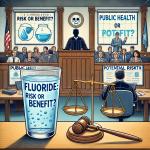In the mid-1800s, the germ theory of disease was finally rooted in the minds of scientists and doctors. It took a bit longer for the idea that food, too, can cause microbial disease to be accepted.
Harm Reduction
Recent headlines spoke to yet another study demonstrating fluoride’s detrimental impact on IQ. Both sides of the controversy took to the media to push their narrative.
Red dye #3, also known as erythrosine, is a food dye that gives food a bright-cherry red color.
Sugar-sweetened beverages (SSBs) are quickly digested, triggering insulin release and other regulatory pathways leading to visceral fat accumulation, insulin resistance in the liver and skeletal muscles, and weight gain.
The $5.6 trillion wellness industry sells a seductive premise: pursue personal well-b
In a contentious age when public health debates often resemble cultural battlegrounds, the nomination of Robert F. Kennedy Jr. as Secretary of Health and Human Services has reignited old controversies.
Health and wellness are intertwined in ways that will be difficult to untangle.
Media reports that black plastic kitchen utensils contain dangerous levels of a flame retardant – decabromodiphenyl ether or decaBDE caused people across the U.S. to throw out their perfectly good kitchen utensils.
Over the course of my career as a science journalist I’ve learned an important but disheartening lesson: experts are allowed to mislead the public about certain health topics. One of the most egregious cases is nicotine vaping.












